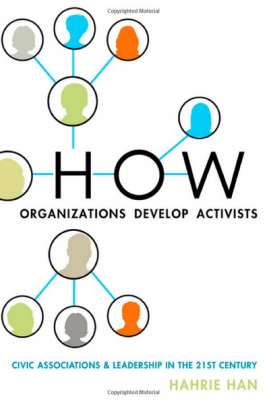Since reading it last year, I’ve been telling anyone who’d listen about why they should read Hahrie Han’s book “How Organizations Develop Activist“.
So I was delighted to be asked to contribute to a special Mobilizing Ideas dialogue on the book. A extract from my review is below, but I’d encourage you to head across to the Mobilizing Ideas blog to read the rest of my review and some cracking contributions from other brilliant organisers and academics.
Han has turned her lens on what she describes as national associations, which appear to be organisations with longstanding programs of grassroots work linked with grasstops influencing, neither mentioned by name but one working in health and the other environment, but you get the impression the lessons are widely applicable.
While there are certainly difference between our approach to grassroots campaigning in the UK to the US, for example less of a focus on state/local level activism, we’re generally keen to learn from trends in the US, and while enjoying the book I was reminded of the lessons from Theda Skocpol’s study on why the push to get action on climate change in 2010 failed in part because it focused too much on grasstops lobbying, rather than the slow work of strategically building power, a sobering lesson for any organisation that nurturing your grassroots matters.
Turning the pages, in the book Han hits the sweet spot in the challenges anyone who works with local chapters or groups. The characterisation of groups being categorised into 3 types, Lone Wolves, Activists and Organiser rings true for anyone who’s been involved in working with local groups.
Lone Wolves being those who chose to ‘to build power by leveraging information — through legal briefs, public comments, and other forms of research advocacy’ while ‘mobilisers and organizers, by contrast, choose to build power through people’.
For many its easy to see activism and organising as the same, but as Jim Coe points out in his review of the book that the ‘two strategic models are in fact based on radically different philosophies and approaches’.
This central idea is one that I found most challenging in the work that I do. I often find myself using the words interchangeably, but as Joy Cushman suggests in the book “The organizer thus makes two [strategic] choices: 1) to engage others, and 2) to invest in their development. The mobilizer only makes the first choice. And the lone wolf makes neither”.
The study is full of practical ideas and evidence insight, for me 5 things stand out as challenges and opportunities for those working in ‘traditional’ organisations or associations looking to build grassroots networks;
- The need to focus on transformational and transactional outcomes – Han refers to the this paper on Metrics that Matter suggesting in the rush to prove to funders and if were honest often others in our organisations the value of our work we can spend too much time focusing on transactional outcomes (the number of emails sent for example) but we need to focus more on transformational outcomes that reflect the often ‘invisible’ work of building capacity and how people have been altered through collective efforts.
- Develop the approach of a coach when working with supporters – groups that had adopted an organising approach were ones that Han understood the need to create a ‘network that grows’, as staff at the heart of an association its easy to revert to an activist approach, but should focus on coaching those involved in groups about how to overcome specific challenges or situations that they are facing.
- Question the narrative – Han talks about the way she observed different chapters making meaning of their work through past experiences “Remember when we got 100 people to attend the meeting”, suggesting its more than just the ‘we’ve always done it this way’ perspective but a sense of believing that we develop a ‘taste’ for specific approach. We need to challenge this.
- Bring people together for fun – the research finds that the most successful chapters or group were those that combined political and social activities, deepening commitment and a sense of shared values. Perhaps a learning that feels obvious in the cold light of day but too often in my experience overlooked.
- Make our approach sticky – making the time to invest in leadership development isn’t easy, but for chapters to succeed the rationale for adopting a particular method of change needs to become ‘sticky’ that is passed on from one generation of leaders to another.
This post first appeared on the Mobilizing Ideas February Essay Dialogues, and can be read in full here.
